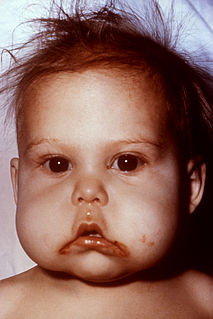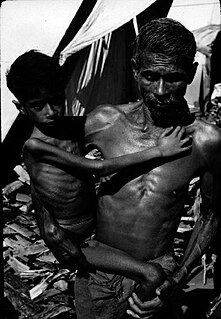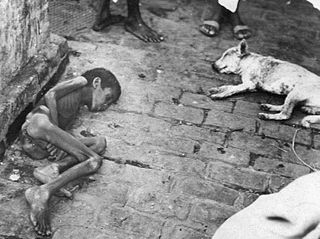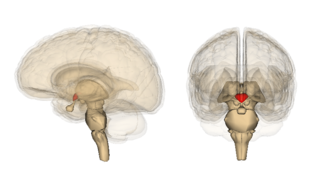 W
WMalnutrition is a condition that results from eating a diet which does not supply a healthy amount of one or more nutrients. This includes diets that have too little nutrients or so many that the diet causes health problems. The nutrients involved can include calories, protein, carbohydrates, fat, vitamins or minerals. A lack of nutrients is called undernutrition or undernourishment while a surplus of nutrients cases overnutrition. Malnutrition is most often used to refer to undernutrition - when an individual is not getting enough calories, protein, or micronutrients. If undernutrition occurs during pregnancy, or before two years of age, it may result in permanent problems with physical and mental development. Extreme undernourishment, known as starvation or chronic hunger, may have symptoms that include: a short height, thin body, very poor energy levels, and swollen legs and abdomen. Those who are malnourished often get infections and are frequently cold. The symptoms of micronutrient deficiencies depend on the micronutrient that is lacking.
 W
WThe Blockade of Germany, or the Blockade of Europe, occurred from 1914 to 1919. It was a prolonged naval operation conducted by the Triple-Entente powers during and after World War I in an effort to restrict the maritime supply of goods to the Central Powers, which included Germany, Austria-Hungary and the Ottoman Empire. It is considered one of the key elements in the eventual Allied victory in the war. The German Board of Public Health in December 1918 claimed that 763,000 German civilians died from starvation and disease caused by the blockade up until the end of December 1918. An academic study done in 1928 put the death toll at 424,000. An additional 100,000 people may have died during the continuation blockade in 1919.
 W
WBP-5 Compact Food is a high-calorie, vitamin fortified, compact, compressed and dry food, often used by relief agencies for the emergency feeding of refugees and internally displaced persons.
 W
WCatabolysis is a biological process in which the body breaks down fat and muscle tissue in order to stay alive. Catabolysis occurs only when there is no longer any source of protein, carbohydrate, or vitamin nourishment feeding all body systems; it is the most severe type of malnutrition.
 W
WCoeliac disease or celiac disease is a long-term immune disorder that primarily affects the small intestine. Classic symptoms include gastrointestinal problems such as chronic diarrhoea, abdominal distention, malabsorption, loss of appetite, and among children failure to grow normally. This often begins between six months and two years of age. Non-classic symptoms are more common, especially in people older than two years. There may be mild or absent gastrointestinal symptoms, a wide number of symptoms involving any part of the body or no obvious symptoms. Coeliac disease was first described in childhood; however, it may develop at any age. It is associated with other autoimmune diseases, such as Type 1 diabetes mellitus and Hashimoto's thyroiditis, among others.
 W
WEmaciation is defined as extreme weight loss and unnatural thinness due to a loss of subcutaneous fat and muscle throughout the body. It affects human beings and animals; one who is emaciated could be described as "wasting away" or being "gaunt." Emaciation is caused by severe malnourishment and starvation. Emaciation is a predominant symptom of malnourishment, a basic component of poverty and famine that also occurs with diseases that interfere with the digestive system and appetite, other systems, and eating disorders. These include nutrient deficiency disorders, diseases with prolonged fever and infection, malignant diseases, parasitic infections that can result from contamination, anorexia nervosa and other conditions. The malnourishment associated with emaciation has been referred to as "inanition", while infection by parasites has been described as "adulteration". Treatment of emaciation includes gradual renourishment with a slow increase of daily caloric intake to help rebuild tissues and regain weight. Rest, and emotional and psychological therapy and support may be included.
 W
WThere were 795 million undernourished people in the world in 2014, a decrease of 216 million since 1990, despite the fact that the world already produces enough food to feed everyone—7 billion people—and could feed more than that—12 billion people.
 W
WA famine is a widespread scarcity of food, caused by several factors including war, inflation, crop failure, population imbalance, or government policies. This phenomenon is usually accompanied or followed by regional malnutrition, starvation, epidemic, and increased mortality. Every inhabited continent in the world has experienced a period of famine throughout history. In the 19th and 20th century, it was generally Southeast and South Asia, as well as Eastern and Central Europe that suffered the most deaths from famine. The numbers dying from famine began to fall sharply from the 2000s.
 W
WA famine food or poverty food is any inexpensive or readily available food used to nourish people in times of hunger and starvation, whether caused by extreme poverty such as during economic depression; by natural disasters, such as drought; or by war or genocide.
 W
WThe Global Hunger Index (GHI) is a tool that measures and tracks hunger globally as well as by region and by country. The GHI is calculated annually, and its results appear in a report issued in October each year.
 W
WFood consumption is the amount of food available for human consumption as estimated by the United Nations Food and Agriculture Organization (FAO) Food Balance Sheets. However, the actual food consumption may be lower than the quantity shown as food availability depends on the magnitude of wastage and losses of food in the household, for example during storage, in preparation and cooking, as plate-waste or quantities fed to domestic animals and pets, thrown or given away.
 W
WMuselmann was a slang term used among captives of World War II Nazi concentration camps to refer to those suffering from a combination of starvation and exhaustion and who were resigned to their impending death. The Muselmann prisoners exhibited severe emaciation and physical weakness, an apathetic listlessness regarding their own fate, and unresponsiveness to their surroundings owing to their barbaric treatment by prisoner functionaries.
 W
WNutribun is a bread product used in elementary school feeding programmes in the Philippines to combat child malnutrition – first as part of the United States Agency for International Development (USAID)'s Food for Peace program from 1971 to 1997, and later as part of the child health programs of various Philippine cities.
 W
W"nutritionDay worldwide" is a large scale, worldwide action project designed to reduce disease related malnutrition among hospitalised patients and nursing home residents. The aim of this project is to increase awareness and knowledge regarding disease related malnutrition in hospitalised patients and the elderly.
 W
WPlumpy'Nut is a peanut-based paste in a plastic wrapper for treatment of severe acute malnutrition manufactured by Nutriset, a French company. Removing the need for hospitalization, the 92-gram packets of this paste can be administered at home and allow larger numbers to be treated.
 W
WProtein poisoning refers to an unverified acute form of malnutrition that some have speculated may be caused by a diet deficient in fat, where excessive lean meat is consumed. The effect may have been treated as a hazard by Lewis and Clark and other frontiersmen of the western United States who lived on game.
 W
WThe prominent knobs of bone at the costochondral joints of rickets patients are known as a rachitic rosary or beading of the ribs. The knobs create the appearance of large beads under the skin of the rib cage, hence the name by analogy with the beads of a Catholic Christian rosary.
 W
WStarvation is a severe deficiency in caloric energy intake, below the level needed to maintain an organism's life. It is the most extreme form of malnutrition. In humans, prolonged starvation can cause permanent organ damage and eventually, death. The term inanition refers to the symptoms and effects of starvation. Starvation may also be used as a means of torture or execution.
 W
WStunted growth is a reduced growth rate in human development. It is a primary manifestation of malnutrition and recurrent infections, such as diarrhea and helminthiasis, in early childhood and even before birth, due to malnutrition during fetal development brought on by a malnourished mother. The definition of stunting according to the World Health Organization (WHO) is for the "height for age" value to be less than two standard deviations of the WHO Child Growth Standards median.
 W
WUndernutrition in children, where an individual is not getting enough calories, protein, or micronutrients, is common globally and may result in both short and long term irreversible negative health outcomes. This is also sometimes called malnutrition, but this could also refer to getting too much food. The World Health Organization (WHO) estimates that malnutrition accounts for 54 percent of child mortality worldwide, about 1 million children. Another estimate also by WHO states that childhood underweight is the cause for about 35% of all deaths of children under the age of five years worldwide.
 W
WWernicke encephalopathy (WE), also Wernicke's encephalopathy is the presence of neurological symptoms caused by biochemical lesions of the central nervous system after exhaustion of B-vitamin reserves, in particular thiamine. The condition is part of a larger group of thiamine deficiency disorders, that includes beriberi in all its forms, and alcoholic Korsakoff syndrome. When it occurs simultaneously with alcoholic Korsakoff syndrome it is known as Wernicke–Korsakoff syndrome.